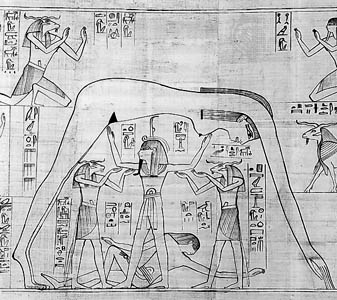2.2: Babylon and Egypt
( \newcommand{\kernel}{\mathrm{null}\,}\)
2.2.1 The Babylonians
One of the earliest human civilizations to leave us records of their astronomical practices was the people of Babylon. The Babylonians developed a sophisticated calendar and had the ability to predict the positions of the planets. They kept records on clay tablets, the earliest of which date to earlier than 1500 BCE. They collected these records from copious observations and from these, we can see a subtle shift in cosmology from the earlier megalithic people. They still saw the Earth as flat, but their view of the world went beyond their immediate environment. The also viewed the sky as a gigantic vault or dome upon which contained the stars. The Sun and the Moon moved across the and they regarded these bodies as being unique and different from the stars. So, we can see the beginnings the celestial sphere model among the Babylonians.
 For ancient people the sky was both their clock and their calendar.
For ancient people the sky was both their clock and their calendar.
"clock" by fsse8info is licensed under CC BY-SA 2.0;
The Babylonians also had a good enough understanding of the motions of the Sun and Moon to craft a lunar calendar. They also had a keen interest in planetary motions, which they used to make astrological predictions. To chart the motions of the planets, the Babylonians developed a sophisticated system of mathematics. Lacking any geometrical model, their mathematics were highly abstract. Also, unlike our modern system based on ten, the Babylonians based their mathematics on the number sixty. We still see remnants of this system in how we measure time, with sixty seconds in a minute and sixty minutes in an hour. This system is also where we get the measurement of 360 degrees in a circle, sixty arcminutes in a degree, and sixty arcseconds in an arcminute.
2.2.2 The Egyptians
The Egyptians had a similar cosmology to the Babylonians in which the sky consisted of the boy of the goddess Nut. The sun god, Ra, traveled across Nut’s back in his boat and then descended into the underworld at night. The sky was attached to the Earth, which the Egyptians considered synonymous with the universe. The Egyptians used obelisks to tell time, much like a sundial uses the movement of its shadow to mark the passage of the hours during the day.


 Obelisk of Thutmosis I in Karnak Hidden categories: CC-BY-SA-3.0-migratedLicense migration completedGFDLMedia missing infobox templateFiles with no machine-readable authorFiles with no machine-readable source;
Obelisk of Thutmosis I in Karnak Hidden categories: CC-BY-SA-3.0-migratedLicense migration completedGFDLMedia missing infobox templateFiles with no machine-readable authorFiles with no machine-readable source; Compared to the Babylonians, however, Egyptians had comparatively less interest in the mathematical measurements of celestial objects. The reasons for this are not quite clear, but it could be that they lacked the mathematical sophistication of the Babylonians. Records from 1100 BCE indicate the Egyptians had only five named constellations. Of particular importance to them was the constellation Orion, which they associated with the god Osiris. Osiris sat in judgment of the dead and determined what fate they received in the afterlife. Two airshafts in the Great Pyramid are aligned with the brightest stars in Orion's belt. One shaft points to where the bright star Thuban would have been 4,500 years ago.

As you might expect in a desert culture, the Egyptians held the Sun in special regard, but they had practical concerns with the stars as well. They divided the night sky into 36 “decans” or star groups that they used to mark the passage of time at night. They also watched for the first appearance of the bright star Sirius; whose appearance coincided with the annual flooding of the Nile River. Every year, when the Nile flooded its banks, it left deposits of nutrient rich silt behind. The Egyptians depended on these deposits to grow their crops. Without these flood waters, Egypt would be a barren land incapable of supporting any agriculture. With the deposits left by the flood waters, however, Egypt became the breadbasket of the Mediterranean and could export grain to many of its neighbors. Knowing when those flood waters would come was therefore, crucial the prosperity of Egyptian civilization.


